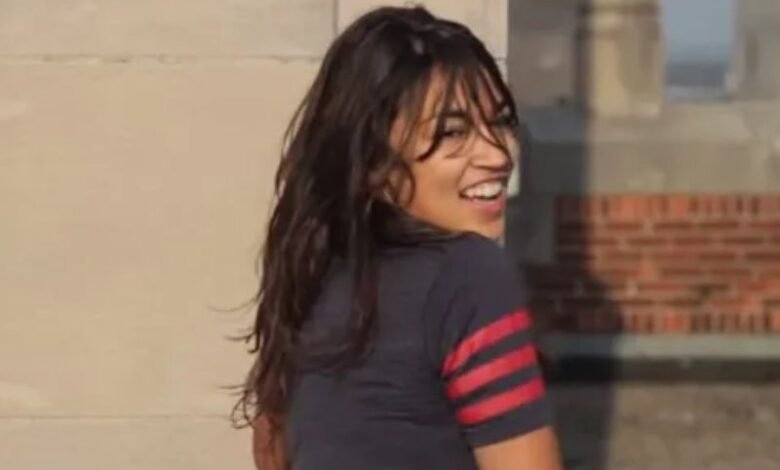Alexandria Ocasio-Cortez Dancing: A Viral Moment
Alexandria Ocasio-Cortez Dancing: A Viral Moment

In the ever-evolving landscape of American politics, authenticity has become both a strength and a vulnerability. Few figures illustrate this balance as vividly as Alexandria Ocasio-Cortez (AOC) — the youngest woman ever elected to the U.S. Congress.
Among the many defining moments in her career, one stands out not for legislative brilliance or fiery debate, but for its simplicity and symbolism — a short clip of her dancing on a college rooftop.
What began as an attempt to mock her became an emblem of joy, confidence, and generational change in politics. The “Alexandria Ocasio-Cortez dancing video” is more than a viral meme — it is a cultural snapshot that reveals how the public relates to authenticity in modern democracy.
Origins of the Video: Boston University, 2010
A Lighthearted College Project
Long before she became a political sensation, Ocasio-Cortez was a student at Boston University, pursuing a degree in International Relations and Economics. Like many students, she was energetic, social, and expressive. Around 2010, AOC joined several classmates in creating a lighthearted rooftop dance video, filmed at BU.
The video was a tribute to the 1985 film The Breakfast Club and featured students re-enacting iconic scenes — this time set to Phoenix’s indie-pop hit “Lisztomania.” Ocasio-Cortez can be seen laughing, dancing, and twirling on the rooftop of a campus building, exuding youthful joy.
The Purpose Behind the Dance
The video was never political. It was part of a student-led creative project — an expression of campus life and community spirit. AOC was known among peers as outgoing and socially engaged, often participating in student activities. Those who knew her described her as “the kind of person who could light up a room,” and the dance video reflected exactly that.
The Viral Moment: 2019 and the Twitter Attempt
A Miscalculated “Gotcha” Moment
Fast-forward nearly a decade later to January 2019, just days before Ocasio-Cortez was sworn in as a member of the U.S. House of Representatives. A short clip from the old video resurfaced online.
It was posted by an anonymous Twitter account with a sneering caption implying that the newly elected congresswoman was unserious and foolish. The user referred to her as a “commie know-it-all acting like a clueless nitwit,” clearly intending to ridicule her.
The Backfire
However, the internet’s response was the opposite of what the poster intended. Rather than outrage or shame, the public reaction was overwhelmingly positive. The video went viral, with millions celebrating AOC’s carefree energy and relatability.
Social media platforms filled with comments such as:
“How dare she… be happy and human?”
“This is the most normal thing I’ve ever seen from a politician.”
“She’s literally just dancing. That’s called having fun.”
It became a cultural moment — a reverse scandal — in which an attempted smear transformed into a testament to authenticity.
AOC’s Response: Dancing Through the Fire
A Playful Rebuttal
AOC’s response was quick, witty, and iconic. She posted a new video of herself dancing outside her congressional office to the song War by Edwin Starr, captioned:
“I hear the GOP thinks women dancing are scandalous. Wait till they find out Congresswomen dance too!”
This single tweet encapsulated what would become her signature communication style — unfiltered, confident, and humor-infused. She turned what could have been a controversy into a moment of empowerment.
Reframing the Narrative
Instead of denying or apologizing, AOC embraced the video’s message. Her approach demonstrated media savvy, showing that authenticity can disarm criticism. She effectively reframed the narrative from “a politician behaving foolishly” to “a young woman unapologetically being herself.”
This was a turning point not only for her image but for how politicians interact with viral culture. It highlighted that in the digital era, authenticity beats artificiality every time.
The Internet’s Reaction: Support, Humor, and Symbolism
The Power of Relatability
For millions of viewers, the video humanized Ocasio-Cortez. In an age when politicians often appear staged or robotic, seeing a lawmaker who once danced like any college student bridged the gap between the governed and the governing.
People connected with her youthfulness and joy. Memes, fan edits, and tributes flooded platforms like Twitter, Instagram, and YouTube. The phrase “Dance like AOC” began trending, symbolizing defiance against double standards faced by women in power.
Celebrity and Media Endorsement
Celebrities, journalists, and public figures joined in the defense. Late-night hosts joked about it affectionately. Musicians praised the use of Lisztomania, and even Phoenix, the band behind the song, saw a spike in streaming numbers after the clip went viral.
In a matter of hours, what began as mockery became a digital standing ovation.
The Broader Meaning: Women, Politics, and Expression
Gender and Double Standards
The “dancing controversy” opened discussions about gender expectations in politics. Why was a woman dancing considered scandalous at all? Male politicians have often engaged in lighthearted public acts — from Barack Obama singing Al Green to George W. Bush dancing with African drummers — yet none faced the same scrutiny.
Ocasio-Cortez’s unapologetic embrace of her past challenged this double standard. She reframed the act of dancing from “unprofessional behavior” to a symbol of liberation — a refusal to be constrained by outdated ideas of how a woman in power should act.
Generational Change
AOC represents a new generation of politicians raised in the age of social media. Unlike traditional figures who treat virality as a threat, she harnesses it as a tool for communication.
Her dancing video became emblematic of millennial authenticity — a quality increasingly valued in public life. It signaled the arrival of a political era where vulnerability, humor, and humanity could coexist with professionalism and influence.
Gender and Generational Contrasts in Politics
Breaking the Mold of Political Decorum
To understand why the AOC dancing video became so symbolic, one must look at the traditional expectations placed on women in politics. For decades, women leaders have been expected to present a specific image: composed, serious, and restrained.
Figures like Nancy Pelosi and Liz Cheney exemplify that generation’s standard — dignified, strategic, and cautious in public demeanor. Their authority stems from discipline and command over image — traits essential for survival in a male-dominated field.
Pelosi’s gestures, Cheney’s tone, their wardrobe, and phrasing — all convey controlled professionalism. They came of age in an era where any display of emotion could be weaponized against a woman in power.
Political Symbolism: Movement as a Metaphor
Dance, as an art form, symbolizes freedom and movement — two qualities deeply tied to the ideals of democracy. The visual of AOC dancing freely on a rooftop became a metaphor for breaking political norms.
She wasn’t just dancing — she was moving differently in a space historically rigid and dominated by older, more conservative figures. That imagery resonated with younger audiences who see politics not as a static institution but as something fluid and participatory.
Public Perception Shift: From Viral Clip to Political Strength
The Empathy Effect
Surveys and sentiment analyses following the incident indicated that public approval of Ocasio-Cortez increased after the video went viral. People found her “real” and “approachable.”
Even critics who disagreed with her politics acknowledged her ability to turn a potential embarrassment into empowerment. The empathy she generated transcended party lines momentarily — a rare phenomenon in polarized politics.
A Lesson in Media Mastery
Political analysts later cited the “AOC dance moment” as a case study in digital media resilience. Rather than suppressing or ignoring viral content, embracing it authentically proved to be the most effective strategy.
Her instinctive response showcased her mastery of the attention economy, where every viral moment can either build or break a public figure’s image.
The Legacy of the Dance: Pop Culture Meets Politics
The Meme That Became a Message
Years later, the “AOC dancing video” remains part of internet folklore. It has been remixed, meme-ified, and referenced in everything from TikTok compilations to political satire shows. Yet its underlying message — that joy can be political — continues to resonate.
Shaping the Modern Political Persona
Ocasio-Cortez’s ability to combine policy seriousness with relatable authenticity has since influenced how younger politicians present themselves online. Her dance video arguably opened the door for other public figures to embrace their humanity without fear of ridicule.
In many ways, her dance wasn’t just a viral moment — it was a cultural permission slip for authenticity in leadership.
Timeline of the “Dancing” Moment in AOC’s Life
| Year | Event | Description |
|---|---|---|
| 2010 | Boston University Rooftop Video | AOC appears in a student film dancing to “Lisztomania” |
| 2018 | Elected to Congress | Becomes youngest woman ever elected to U.S. House |
| Jan 2019 | Video Resurfaces | Anonymous Twitter user posts clip to mock her |
| Jan 4, 2019 | AOC Responds | Posts her own dance clip outside her office |
| 2019–Present | Cultural Impact | Video becomes symbol of authenticity in politics |
Alexandria Ocasio-Cortez’s Life and Career Highlights
| Milestone | Year | Age | Details |
|---|---|---|---|
| Birth | 1989 | 0 | Born in the Bronx, New York |
| Boston University Graduation | 2011 | 22 | Earned BA in Economics and International Relations |
| Bartending Career | 2011–2016 | 22–27 | Worked various jobs before entering politics |
| Congressional Campaign | 2018 | 28 | Defeated incumbent Joe Crowley in Democratic primary |
| Elected to Congress | 2018 | 29 | Youngest woman ever elected to U.S. House |
| “Dancing Video” Resurfaced | 2019 | 29 | Viral moment of cultural and political significance |
| Re-election | 2020 | 31 | Won re-election with strong public support |
Lessons from the “AOC Dancing” Moment
Authenticity Is Irreplaceable
Audiences crave sincerity in a world of political scripts. AOC’s dancing moment connected because it was real, not manufactured.
Humor Disarms Criticism
By responding playfully rather than defensively, Ocasio-Cortez demonstrated emotional intelligence — turning hostility into humor.
Representation Matters
Her dancing affirmed that women, particularly young women of color, can be both powerful and joyful without compromising credibility.
The Internet Is a Mirror, Not a Weapon
The public reaction showed that attempts to weaponize joy or normal behavior often reflect more on the attacker than the target.
Movement Is Power
In both a literal and symbolic sense, her dance represented movement — a break from stillness and rigidity that defines much of traditional politics.
Cultural and Political Significance
The “AOC dancing video” is now studied not only as a viral phenomenon but as a cultural artifact. It highlights how the intersection of youth, gender, media, and politics defines 21st-century leadership.
It also reminds us that public figures are not born politicians; they are human beings shaped by experiences, friendships, and small moments of joy — even a rooftop dance.
For younger generations, AOC’s response validated that being true to oneself isn’t a liability. For the political establishment, it served as a wake-up call: the public no longer rewards perfection — it rewards honesty.
Frequently Asked Questions (FAQs)
What song was Alexandria Ocasio-Cortez dancing to in the viral video?
She was dancing to “Lisztomania” by the French indie band Phoenix in a Boston University student project inspired by The Breakfast Club.
When was the dancing video filmed?
The video was filmed around 2010, during Ocasio-Cortez’s time as an undergraduate student at Boston University.
Why did the video go viral in 2019?
An anonymous Twitter user tried to use it to mock her shortly before her congressional swearing-in, but the attempt backfired, leading to widespread support and admiration.
How did Alexandria Ocasio-Cortez respond to the video resurfacing?
She posted a playful video of herself dancing outside her congressional office, embracing the moment and turning it into a symbol of confidence and authenticity.
What did the AOC dancing video symbolize?
It symbolized freedom, authenticity, and the dismantling of outdated gender norms in politics, proving that joy and professionalism can coexist.



